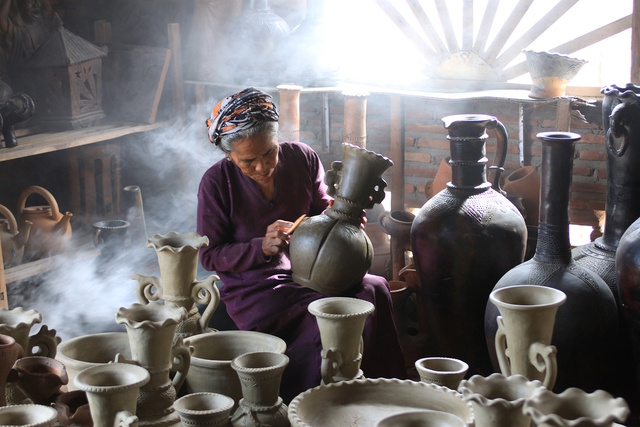The Cham pottery craft is an ancient traditional craft closely linked to the history and culture of the Cham people, especially in the central and southern central provinces of Vietnam such as Ninh Thuận, Bình Thuận, and Quảng Nam. Cham pottery is not only used in daily life but also carries deep religious and spiritual values, showcasing the creativity and skill of the Cham people.
1. History and Origin
The Cham pottery craft has a history spanning thousands of years, originating from the need for pottery in daily life and religious rituals.
During the Champa period, the Cham people became famous for their pottery techniques and the production of unique pottery products. Archaeological sites show that the Cham people were crafting pottery early on, using these products for worship, rituals, as well as in daily life.
2. Pottery-making Process
Materials: Cham pottery is primarily made from clay, which is sourced from the red basalt soil areas, known for its high plasticity and ease of shaping. The clay is thoroughly kneaded to create a smooth texture.
Pottery-making steps: Artisans often use a potter’s wheel or their hands to shape the pottery. Some larger items like jars, vases, and pots may require a combination of handcrafting and mold use.
Firing the pottery: After the pottery is shaped and dried, it is fired in a traditional kiln. The firing temperature typically ranges from 800 to 1000 degrees Celsius, making the pottery hard and durable. After firing, the pottery has distinctive colors like red, light yellow, or black depending on the type of clay and the firing method.
3. Cham Pottery Products
Household items: Bowls, plates, pots, vases, jars, and other basic pottery items are essential in the daily life of the Cham people. These products not only serve practical purposes but are also decorated with unique patterns.
Religious items: Cham pottery is also renowned for its religious products, such as statues of gods, altar lamps, offering bowls, and especially the intricate sculptures used in Cham temples and towers. These statues and altar sculptures reflect the Cham people’s religious beliefs, honoring gods and ancestors.
Decorative items: Pottery vases, decorative jars, and ornamental items made from pottery are often beautifully crafted with elegant designs that reflect the Cham people’s life and beliefs.
4. Patterns and Decoration of Pottery
The patterns on Cham pottery are very diverse, combining elements of nature, animals, mythology, and religious symbols. These patterns express the connection between humans, nature, and deities.
The motifs on Cham pottery may include images of Hindu gods, lotus flowers, dragons, birds, or symbols influenced by Indian and Southeast Asian cultures.
5. Cultural and Social Value
The Cham pottery craft holds not only economic value but also serves as an essential part of the Cham people’s culture, religion, and spirituality. Pottery products are not only used in daily life but also play an important role in spiritual ceremonies.
The pottery craft is also an inseparable part of Cham festivals and traditions, including seasonal festivals, religious ceremonies, and wedding rituals.
6. Preservation and Promotion
Although the Cham pottery craft has faced many challenges from industrialization, modernization, and changing market demands, the craft is still being preserved and promoted through traditional craft villages.
Cham pottery products not only serve domestic needs but are also exported abroad, helping maintain the traditional craft and generate income for the Cham community.
Cultural organizations and communities are actively organizing educational, training, and preservation activities for Cham pottery, as well as promoting the cultural values of this craft through competitions and cultural events both domestically and internationally.

